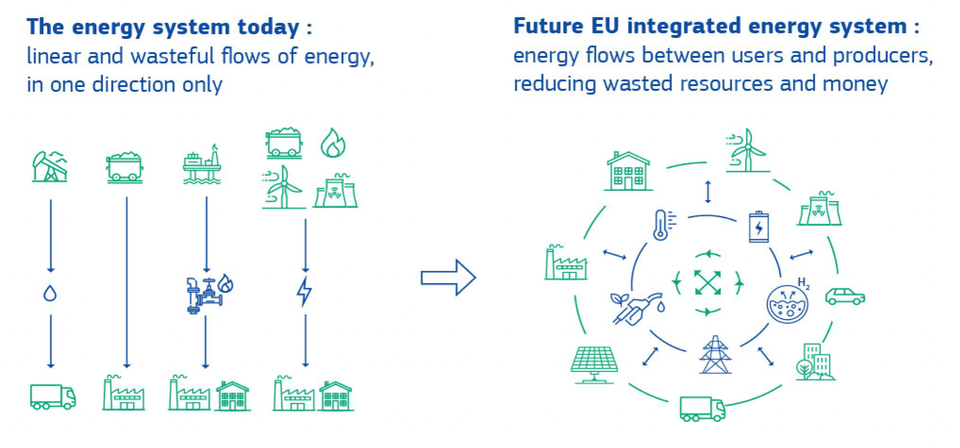What being European means for Irish Energy

I’m Irish, but I’m also European and I’m proud of both. Though to be fair, I’m actually from Cork so that trumps everything and I’m typically annoying about it. It’s amazing to think that I can hold these three viewpoints in my head at the same time without it exploding, but I’m used to it now because of constantly having to consider what the World Energy Council calls the energy trilemma – for an energy system to be successful, it needs to be sustainable, affordable, and equitable.
The European Union is implementing the energy transition to a climate neutral continent by 2050 by considering these three complementary aspects. Following on from the European Green Deal, 2021 saw the release of two clever strategies around the same time. The first was Energy System Integration Strategy. It links various energy carriers such as electricity, heat, gas solid and liquid fuels with each other and with the end-use sectors, such as buildings, transport of industry.
So rather than think in lines, it seeks to think in circles. For example, keeping a data centre cool involves removing heat from the servers. That heat could be redirected into a district heating scheme. Another example could be the energy in waste food could be converted into biogas which can in turn generate electricity. It’s hard not to like the idea really, because it appeals to our sensibility of “waste not want not”.
The EU policy writers were even more ambitious though, they chose to find ways to integrated renewable energy with every possible end use. Some of it is straight forward, wind turns turbines which generate electricity, so we light our homes, power our electric vehicles, and keep our hospitals operational for example. However, we need the wind and sun to displace all our fossil fuels and that’s why the EU released the European Hydrogen Strategy to enable the European Energy System Integration Strategy.
When renewable electricity is passed through water (H2O) the H (hydrogen) and the O(oxygen) are separated and can both be used; the oxygen in water treatment for example, and the hydrogen, well that’s where the fun starts! When there is more wind powered electricity than is needed, that energy can be stored as hydrogen. On calm days, that fuel can be used to power electricity plants. We can more easily store and transport energy as a fuel, so hydrogen can replace coal, oil, and natural gas. Hydrogen could replace national oil reserves; and it can be used to power things we can’t plug in, like airplanes and steel factories.
Following on from the European Green Deal and supporting policies came “Fit for 55” - a plan for 55% reduction in emissions by 2030, so on track for sustainability …. But as we know there are another two legs to the energy trilemma stool, we need systems to be affordable and provide security of supply. Towards the end of 2021, there was a tolerable level of risk around security of supply and mostly energy was a begrudgingly paid living expense; after all we were still getting our heads around post COVID19 recoveries on personal and national levels.
Then came the Russian invasion of Ukraine and very quickly the EU responded with the RePowerEU plan, a plan to rapidly reduce dependence on Russian fossil fuels and fast forward the green transition to capitalise on the potential for lower cost energy from European and imported sources. Cost is such a wishy-washy term and typically assigns a monetary proxy to value. I prefer Henry Thoreau who said, “the cost of anything is the amount of life we exchange for it”. So, when we consider the third element of the energy system, affordability; it is sometimes described as equity.
RePowerEU seeks to save energy, diversify supplies, accelerate renewables, and reduce fossil fuels. It is going faster and further with clean energy projects and quadruples the role for hydrogen by 2030.
As Europeans, we Irish will have a strong role to play because of the amount of energy we have in the form of wind off our coast. We can become a source of energy for Europe. We can export energy in the form of electricity via interconnectors as well as in the form of hydrogen. We can provide energy in a democratic way which will in turn avoid new forms of green colonialism or store up geopolitical problems for future generations. For an integrated energy system isn’t just about the technology or forms of energy, it’s about the citizens and countries collaborating in a way that hasn’t been seen before. We can think of the energy transition as an opportunity to create a new way of doing business; one where a rising tide lifts all boats. Each MW of offshore wind is estimated to contribute two billion euros of economic benefit. For citizens benefitting from those greener jobs, they will also be empowered as energy citizens and enable the social licence needed for the transition.
Finally, and probably most importantly, we in Cork can help Ireland and Europe. We have the ports, the wind resource, the research institutions to make sure we can play our part and in return achieve the economic benefit for our citizens. We can do this by being rebellious and creating the new energy future. By collaborating as people in the first instance, we can achieve an integrated energy system which gives us a stronger Cork, Ireland, and Europe.